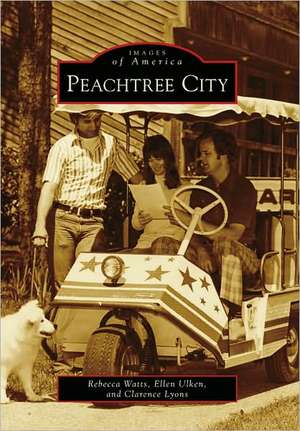Peachtree City: Images of America (Arcadia Publishing)
Autor Rebecca Watts, Ellen Ulken, Clarence Lyonsen Limba Engleză Paperback – 31 mar 2009
Din seria Images of America (Arcadia Publishing)
-
 Preț: 129.71 lei
Preț: 129.71 lei -
 Preț: 129.71 lei
Preț: 129.71 lei -
 Preț: 130.74 lei
Preț: 130.74 lei -
 Preț: 129.71 lei
Preț: 129.71 lei -
 Preț: 125.22 lei
Preț: 125.22 lei -
 Preț: 130.74 lei
Preț: 130.74 lei -
 Preț: 130.74 lei
Preț: 130.74 lei -
 Preț: 130.92 lei
Preț: 130.92 lei -
 Preț: 131.15 lei
Preț: 131.15 lei -
 Preț: 115.50 lei
Preț: 115.50 lei -
 Preț: 130.97 lei
Preț: 130.97 lei -
 Preț: 129.49 lei
Preț: 129.49 lei -
 Preț: 115.72 lei
Preț: 115.72 lei -
 Preț: 126.07 lei
Preț: 126.07 lei -
 Preț: 130.29 lei
Preț: 130.29 lei -
 Preț: 126.07 lei
Preț: 126.07 lei -
 Preț: 115.72 lei
Preț: 115.72 lei -
 Preț: 129.89 lei
Preț: 129.89 lei -
 Preț: 125.06 lei
Preț: 125.06 lei -
 Preț: 132.42 lei
Preț: 132.42 lei -
 Preț: 129.71 lei
Preț: 129.71 lei -
 Preț: 129.71 lei
Preț: 129.71 lei -
 Preț: 129.71 lei
Preț: 129.71 lei -
 Preț: 125.06 lei
Preț: 125.06 lei -
 Preț: 129.71 lei
Preț: 129.71 lei -
 Preț: 125.06 lei
Preț: 125.06 lei -
 Preț: 130.52 lei
Preț: 130.52 lei -
 Preț: 118.36 lei
Preț: 118.36 lei -
 Preț: 125.22 lei
Preț: 125.22 lei -
 Preț: 125.46 lei
Preț: 125.46 lei -
 Preț: 130.74 lei
Preț: 130.74 lei -
 Preț: 133.96 lei
Preț: 133.96 lei -
 Preț: 132.18 lei
Preț: 132.18 lei -
 Preț: 116.31 lei
Preț: 116.31 lei -
 Preț: 129.71 lei
Preț: 129.71 lei -
 Preț: 130.92 lei
Preț: 130.92 lei -
 Preț: 130.92 lei
Preț: 130.92 lei -
 Preț: 131.15 lei
Preț: 131.15 lei -
 Preț: 131.15 lei
Preț: 131.15 lei -
 Preț: 130.74 lei
Preț: 130.74 lei -
 Preț: 129.71 lei
Preț: 129.71 lei -
 Preț: 129.71 lei
Preț: 129.71 lei -
 Preț: 130.74 lei
Preț: 130.74 lei -
 Preț: 131.15 lei
Preț: 131.15 lei -
 Preț: 129.49 lei
Preț: 129.49 lei -
 Preț: 130.97 lei
Preț: 130.97 lei -
 Preț: 127.08 lei
Preț: 127.08 lei -
 Preț: 129.71 lei
Preț: 129.71 lei -
 Preț: 173.20 lei
Preț: 173.20 lei -
 Preț: 116.13 lei
Preț: 116.13 lei
Preț: 133.77 lei
Nou
Puncte Express: 201
Preț estimativ în valută:
25.61€ • 26.34$ • 21.25£
25.61€ • 26.34$ • 21.25£
Carte indisponibilă temporar
Doresc să fiu notificat când acest titlu va fi disponibil:
Se trimite...
Preluare comenzi: 021 569.72.76
Specificații
ISBN-13: 9780738568157
ISBN-10: 0738568155
Pagini: 127
Dimensiuni: 163 x 231 x 10 mm
Greutate: 0.39 kg
Editura: Arcadia Publishing (SC)
Seria Images of America (Arcadia Publishing)
ISBN-10: 0738568155
Pagini: 127
Dimensiuni: 163 x 231 x 10 mm
Greutate: 0.39 kg
Editura: Arcadia Publishing (SC)
Seria Images of America (Arcadia Publishing)
Descriere
In 2009, Peachtree City is a 50-year-old thriving A[a¬Anew town.A[a¬A But when it was incorporated in 1959, it was 5,000 acres of farmland with little more than potential. The 1960 census did not record an official count until implored to three years later so that the city could apply for federal funds. Even by the next federal census, the city had less than 1,000 people. However, by the mid-1970s, the population was close to 5,000, and the next three decades saw phenomenal growth as the city kept a balance between industry, greenspace, and the needs of its residents. Moving from potential to fruition takes planning, cooperation, and determination from a cityA[a¬a[s leaders. In the late 1950s, young Georgia Tech student Joel Cowan enlisted the help of local banker and insider Floy Farr, and together they laid the foundation for Peachtree City. The 1980s and 1990s would see increased growth as word spread about GeorgiaA[a¬a[s planned community and its vast promise for a near-perfect life. Peachtree City is one of AmericaA[a¬a[s A[a¬Anew townsA[a¬A that did not go bustA[a¬amanaging to go from bud, to boom, to bloom . . . a place its residents A[a¬Alove to call home.A[a¬A
Notă biografică
Rebecca Watts, librarian and archivist with Peachtree City Library; Ellen Ulken, author of Beautiful Dreamer: The Life of Stephen Collins Foster; and Clarence Lyons, retired archivist with 35 years of experience with the National Archives, have played detectives for the past two years, discovering a range of photographic images and building the city's photographic archives along the way.
